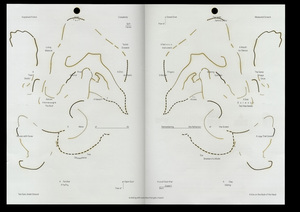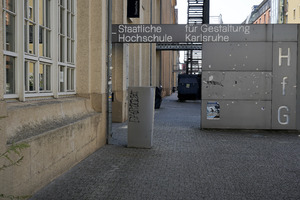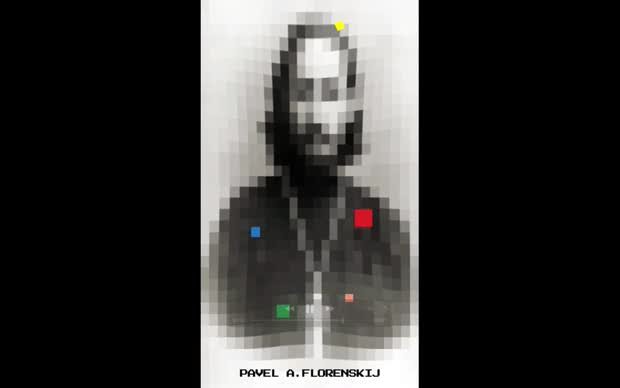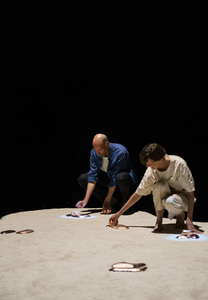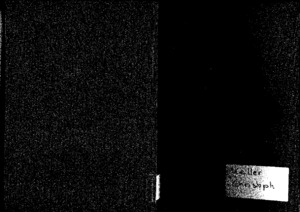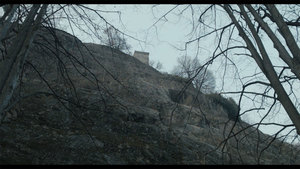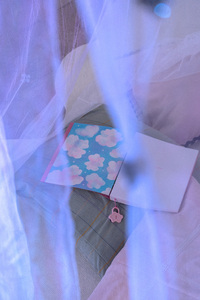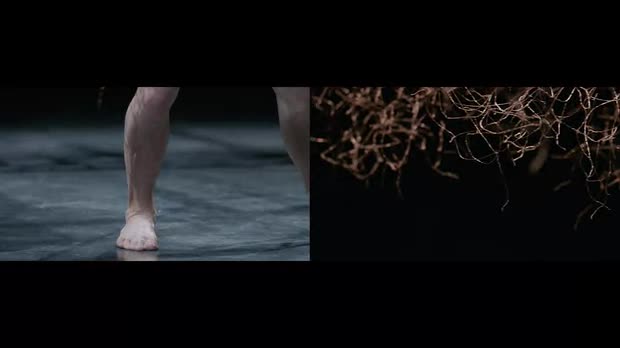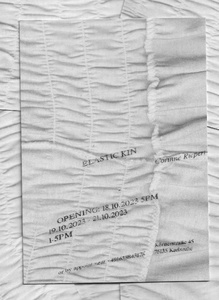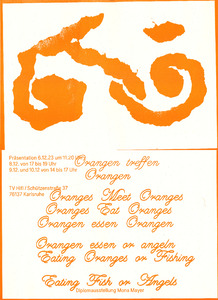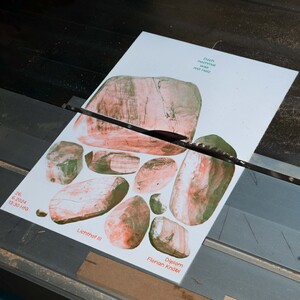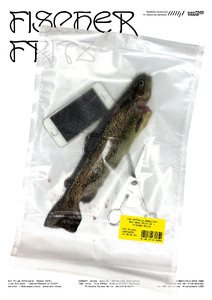WHERE LEGENDS ARE MADE AND LIES ARE TOLD
Benachbarte Sets (54)Alle Zusammenhänge anzeigen
Diese Sets wurden den gleichen Sets hinzugefügt wie das ausgewählte Set.
54 Inhalte
- Seite 1 von 5
I Cried A Smile
- Titel
- I Cried A Smile
- Autor/in
- Beschreibung (de)
- Mit den Mitteln einer wissenschaftlichen Lecture erzählt „I Cried A Smile“ eine Geschichte über eine Person mit 2 Köpfen, Holz das zu Menschen wird, und die Erinnerung daran als Kind mit Neuropsychologie in Kontakt zu treten. Zwei übereinander hängende Projektionsflächen zeigen Zeichnungen, Animationen und gefundenes Bildmaterial während meine Stimme vom Band läuft und ich an einem Schreibtisch sitzend, mit dem Verfahren „Lip-Sync“ lautlos mitspreche. Das Publikum sitzt wie in einem anatomischen Theater in zwei Halbkreisen um mich herum.
- Beschreibung (en)
- Using the means of a scientific lecture, “I Cried A Smile” tells a story about a person with two heads, wood that becomes human, and the memory of coming into contact with neuropsychology as a child. Two projection screens hanging above me showcasing drawings, animations and found footage while my voice runs from the tape and I, sitting at a desk, speak along inaudibly using the “Lip-Sync” method. The audience sits around me like in an anatomical theater.
- Using the means of a scientific lecture, “I Cried A Smile” tells a story about a person with two heads, wood that becomes human, and the memory of coming into contact with neuropsychology as a child. Two projection screens hanging above me showcasing drawings, animations and found footage while my voice runs from the tape and I, sitting at a desk, speak along inaudibly using the “Lip-Sync” method. The audience sits around me like in an anatomical theater.
- Kategorie
- Typ des Projekts/Werks
- Schlagworte
- Mitwirkende
- Technik/Verfahren/Formate
- 2 Channel Video
- Dauer
- 8 Minuten
- Ort: Institution
- Stadt
- Land
- Titel
- I Cried A Smile
- Importiert am
- 30.09.2024
- Übergeordnete Sets
- 0
- Set enthält
- 0 5
HfG Karlsruhe Gebäude
- Titel
- HfG Karlsruhe Gebäude
- Titel (en)
- Innen- und Außenansichten der HfG Karlsruhe
- Beschreibung (de)
- Fotos von Jehad Othman
- Kategorie
- Schlagworte
- Ort
- HfG Karlsruhe Gebäude Ansicht Seite Brauerstraße und Seite Lorenzstraße sowie Innenansichten des Gebäudes
- Stadt
- Land
- Auftrag durch
- Presseabteilung HfG Karlsruhe
- Titel
- HfG Karlsruhe Gebäude
- Importiert am
- 30.09.2024
- Übergeordnete Sets
- 1
- Set enthält
- 0 1
G.O.T.T.A.L.I.S.T.E.N.
- Titel
- G.O.T.T.A.L.I.S.T.E.N.
- Autor/in
- Beschreibung (de)
- "GOTTALISTEN", kurz für „Grab One Terrene Thought And Let It Slide To Eternal Nothingness”, beschäftigt sich mit der Zeit der Oktoberrevolution in Russland im Jahr 1917. Die Klebeband-Leinwände nehmen Bezug auf den Künstler Kasimir Malewitsch, der während dieser Epoche in Russland lebte. Zudem setzt Claus sich mit dem russischen Religionsphilosoph, Priester, Mathematiker und Kunstwissenschaftler Pavel Florenskij auseinander.
- Beschreibung (en)
- "GOTTALISTEN", short for "Grab One Terrene Thought And Let It Slide To Eternal Nothingness", deals with the time of the October Revolution in Russia in 1917. The tape canvases refer to the artist Kasimir Malewitsch, who lived in Russia during this era. Claus also deals with the Russian religious philosopher, priest, mathematician and art historian Pavel Florenskij.
- Kategorie
- Schlagworte
- Titel
- G.O.T.T.A.L.I.S.T.E.N.
- Projektleiter/in
- Semester
- Studiengang
- Typ der Abschlussarbeit
- Importiert am
- 08.08.2024
- Übergeordnete Sets
- 0
- Set enthält
- 1 27
finding traces and placing connections
- Titel
- finding traces and placing connections
- Autor/in
- Beschreibung (de)
- „finding traces and placing connections“ ist eine interaktive Kunstinstallation und ein persönlicher Liebesbrief an das Material Kupfer. Die Arbeit zelebriert die Funktionalität, Vielseitigkeit und Schönheit des Kupfers.
Besucher*innen können die in den Teppich eingelassenen Kupferflächen durch fünf verkupferte Steine verbinden und kontrollieren dadurch Klang und Licht des Raumes.
Die Komposition für das Werk wurde aus Aufnahmen, die durch Interaktion mit Kupferobjekten entstanden sind, generiert.
Jede aktivierte Fläche leuchtet auf und fügt eine Audiospur zur Komposition hinzu.
Dadurch entsteht nicht nur eine Interaktion mit der Arbeit, sondern auch eine Interaktion zwischen den Besucher*innen. Durch das Zusammenspiel entstehen individuelle Kompositionen und Kombinationen der Audiospuren und immer neue Abwandlungen des Klanges.
„finding traces and placing connections“ lädt ein, zu entdecken, zu hören.
- „finding traces and placing connections“ ist eine interaktive Kunstinstallation und ein persönlicher Liebesbrief an das Material Kupfer. Die Arbeit zelebriert die Funktionalität, Vielseitigkeit und Schönheit des Kupfers.
- Beschreibung (en)
- “finding traces and placing connections” is an interactive art installation and a personal love letter to the material copper. The work celebrates the functionality, versatility and beauty of copper.
Visitors can connect the copper surfaces embedded in the carpet with five copper-plated stones and thereby control the sound and light of the room.
The composition for the work was generated from recordings made through interaction with copper objects.
Each activated surface lights up and adds an audio track to the composition.
This not only creates an interaction with the work, but also an interaction between the visitors. The interplay creates individual compositions and combinations of audio tracks and ever new variations of the sound.
“finding traces and placing connections” invites you to discover and listen.
- “finding traces and placing connections” is an interactive art installation and a personal love letter to the material copper. The work celebrates the functionality, versatility and beauty of copper.
- Kategorie
- Typ des Projekts/Werks
- Schlagworte
- Datierung
- Juni 2024
- Mitwirkende
- Dank an
- Material
- Abmessungen
- 4m x 5m
- Ort: Institution
- Titel
- finding traces and placing connections
- Projektleiter/in
- Semester
- Studiengang
- Typ der Abschlussarbeit
- Importiert am
- 05.11.2024
- Übergeordnete Sets
- 3
- Set enthält
- 0 23
Excreta Fluxorum - Theatrum Instrumentorum
- Titel
- Excreta Fluxorum - Theatrum Instrumentorum
- Untertitel
- George Maciunas und die Kultur der „curiositas”
- Autor/in
- Beschreibung (de)
- „Möglicherweise erscheinen die intermediären Kunstformen der 60er-jahre als zu komplex, ihre Manifestationen zu sehr als Teil einer noch lebenden Kunstgeschichte, vielleicht hindert auch die noch nicht abgeschlossene Bewältigung der postmodernen Wende in Philosophie, Kunst und Literatur an einer generalüberholten wissenschaftlichen Annäherung an diesen Themenbereich, der sich von der fließenden, aus Künstlerkommentaren über Kritiken in methodischen Darstellungen hervorgegangenen bisherigen Versuchen einer vorläufigen Einordnung des Phänomens Fluxus abzugrenzen hätte."
- Beschreibung (en)
- “It is possible that the intermediary art forms of the 1960s appear too complex, their manifestations too much a part of a still living art history; perhaps the fact that the postmodern turn in philosophy, art and literature has not yet been completed also prevents a generally overhauled academic approach to this subject area, which would have to distinguish itself from the fluid attempts at a provisional classification of the phenomenon of Fluxus that have emerged from artists' commentaries on critiques in methodical presentations.”
- Kategorie
- Typ des Projekts/Werks
- Schlagworte
- Datierung
- 04.03.1999
- Sprache
- Ort: Institution
- Stadt
- Land
- Titel
- Excreta Fluxorum - Theatrum Instrumentorum
- Projektleiter/in
- Semester
- Studiengang
- Typ der Abschlussarbeit
- Archiv-Signatur
- HfG HS 1999 01
- Externes Archiv
- Importiert am
- 11.01.2024
- Übergeordnete Sets
- 3
- Set enthält
- 0 3
ETWAS BLEIBT
- Titel
- ETWAS BLEIBT
- Titel (en)
- WHAT REMAINS
- Autor/in
- Beschreibung (de)
- Etwas bleibt ist ein Portrait über einen Flecken Erde.
Etwas bleibt ist der Klang dieser Landschaft.
Etwas bleibt ist die Erzählung einer Geschichte.
Elenya Bannert beschäftigt sich in ihrer filmischen Erzählung mit dem Alter, dem Vergessen, den Anforderungen unserer heutigen Zeit und einem Leben, das so nur noch selten zu finden ist.
Matteo ist alt, er lebt alleine auf einer Alm. Er ist jedoch nicht ganz alleine: Seine Kuh erinnert ihn von Zeit zu Zeit daran, gemolken werden zu wollen. Das Lesen fällt ihm schwer und auch sonst wird Matteo ein wenig vergesslich und wunderlich.
Die finalen Dreharbeiten zu dem Film begannen im März 2017. Das idyllische Dorf Soglio, im Kanton Graubünden / Schweiz, dient als Schauplatz für die Geschichte.
Um mit Bild, Ton und Narration gleichwertig umgehen zu können, verzichtet dieser Film konsequent auf schauspielerische Leistung und erzählt aus der Sicht der Tochter, wodurch der narrative Charakter der Geschichte stark in den Vordergrund tritt.
Das filmische Material, das entstanden ist, wirkt auf stimmungsvolle Weise dokumentarisch und unterstützt den Betrachter darin, sich mit seiner individuellen Phantasie auseinanderzusetzen.
- Etwas bleibt ist ein Portrait über einen Flecken Erde.
- Beschreibung (en)
- What remains is a portrait of a spot of earth.
What remains is the sound of the landscape.
What remains is the telling of a story.
In her cinematic narrative, Elenya Bannert deals with the concepts of age, forgetting, the demands of our current times, and a life that is nowadays so hard to come by.
Matteo is old, and lives alone on an Alpine pasture. He is, however, not completely alone; his cow reminds him from time to time that she needs milking. Reading has become difficult for Matteo, and he has also become a little forgetful and peculiar.
The final film shoot began in March 2017. The idyllic village of Soglio in the canton of Graubünden / Schweiz serves as the backdrop for the story.
In order to be able to deal with image, sound and narration equally, the film consequently rejects acting, and the story is told through the eyes of the daughter, bringing the narrative character of the story distinctly to the fore.
The emerging cinematic material appears documentary in an atmospheric way and encourages the viewer to confront individual phantasies.
- What remains is a portrait of a spot of earth.
- Typ des Projekts/Werks
- Datierung
- 2017
- Mitwirkende
- Sprache
- Material
- Dauer
- 10 min
- Bemerkungen
- Buch & Regie: Elenya Bannert
Kamera: Tilmann Rödiger
Sounddesign: Max Lange
Musik: Kalkhofer
- Buch & Regie: Elenya Bannert
- Titel
- ETWAS BLEIBT
- Projektleiter/in
- Semester
- Importiert am
- 20.07.2018
- Übergeordnete Sets
- 0
- Set enthält
- 0 6
eternal girlhood
- Titel
- eternal girlhood
- Untertitel
- oh my dreams
- Autor/in
- Beschreibung (de)
- “eternal girlhood” ist eine konzeptionelle Arbeit, welche aus einer Rauminstallation und einer Publikation besteht.
Ursprünglich in den Chinesischen Pavillons des Fasanengarten in Karlsruhe installiert, wurden durch Requisiten sowie einem selbst produzierten Musikstück, der Raum mit der Handlung der Publikation, verknüpft.
Das Projekt ermöglicht eine Reise in eine poetische Geschichte, inspiriert von persönlichen und kulturellen Themen wie Girlhood, Coming-of-Age und Growing Pains.
Die Handgebundene Publikation mit glitzerndem und geprägtem Umschlag umfasst auf ca. 100 Seiten neben Serien Analoger Schwarzweiß-Fotografie farbige Mittelformat Fotos, begleitet von analogen Schnappschüssen und Riso gedruckte Illustrationen.
Zwischen Fotoserien und Illustrationen, sind Songtexte sowie Skript-fragmente und Gedichte eingestreut, in Referenz zu Filmsequenzen aus Coming of Age Geschichten. Es ergibt sich die zeitlose Skizze eines Mädchens die Teil einer innig verbundenen Mädchengruppe ist.
Transparente Drucke von drei Mittelformat Fotografien werden vom Fensterlicht erleuchtet und symbolisieren in Zusammenarbeit mit dem Buch unterschiedliche Kapitel der Geschichte.
Unter einem Baldachin, umgeben von funkelnd tanzenden Schmetterlingen können Besucher*innen in diese Welt eintauchen und sind eingeladen, für einen Moment Teil von „eternal girlhood“ zu sein, fernab der Echtzeit.
- “eternal girlhood” ist eine konzeptionelle Arbeit, welche aus einer Rauminstallation und einer Publikation besteht.
- Beschreibung (en)
- “eternal girlhood“ is a conceptional Artwork, blending a publication with its installation space.
Initially installed in the Chinese pavillons of the Fasanengarten in Karlsruhe, the space was connected to the story of the book through props and a musical sound score.
The project offers a journey into a poetic Story, inspired by personal and cultural ideas on girlhood, coming of age and growing pains.
Handbound, wrapped in a glittery embossed Dustcover, the Publication features around 100 Pages with multiple series of black and white film photography, medium format shots underlined by analog snapshots and Riso printed Illustrations. In between the Chapters of Photography and Illustrations, lyrics, fragments of script and poems are inserted in reference to movie sequences from coming of age stories. A timeless profile of a girl being part of girlhood and a deeply connected friendship is created.
Transparent prints of three medium format photos are illuminated by the windows’ natural light and symbolize different chapters of the story in collaboration with the book.
Underneath a canopy, surrounded by sparkling dancing butterflies, Visitors can dive into this World and are invited to become part of “eternal girlhood“, away from modern reality.
- “eternal girlhood“ is a conceptional Artwork, blending a publication with its installation space.
- Kategorie
- Typ des Projekts/Werks
- Schlagworte
- Datierung
- 05.07.2024
- Mitwirkende
- Dank an
- Sprache
- Material
- Technik/Verfahren/Formate
- Risographie Druck, Digitaldruck, Mediumformat Fotografie, Schreibmaschine, Laser, Prägung
- Abmessungen
- Fläche: ca. 5m x 5m, Höhe der Aufhängung ca. 3m
- Ort: Institution
- Ort
- Chinesische Pavilions des Fasanengarten
- Stadt
- Land
- Beteiligte Institution(en)
- Titel
- eternal girlhood
- Projektleiter/in
- Studiengang
- Typ der Abschlussarbeit
- Importiert am
- 05.11.2024
- Übergeordnete Sets
- 1
- Set enthält
- 0 21
Ephemeral Antipodes
- Titel
- Ephemeral Antipodes
- Titel (en)
- Ephemeral Antipodes
- Autor/in
- Beschreibung (de)
- "Ephemeral Antipodes" ist eine interaktive, Raum einnehmende Klanginstallation. Die Adern der elektronischen Welt, simple Stromkabel, wachsen zu Kupferskulpturen heran. Aufgrund menschlichen Handelns erzeugen analoge Bauteile auf Platinen den Klang und fragile, in Ton gefasste Lautsprecher brechen unter der Last ihrer eigenen Resonanz zusammen. Durch den schmalen Eingang betritt man einen nur spärlich beleuchteten Raum. Seine Wände verschwinden in der Dunkelheit und erzeugen die Illusion einer grenzenlosen Tiefe.
Es lässt sich nur schemenhaft ein metallisch glänzender Wald aus nadelbaumartigen, schwebenden Adern ausmachen. Meterlange, versetzt angebrachte Skulpturen entflochtener Kupferkabel nehmen das komplette erste Drittel des Raumes ein. Die einzelnen Kabeläste hängen so eng nebeneinander, dass beim Versuch hindurchzukommen sich zwangsläufig Kabel berühren. Wegen der Leitfähigkeit des Kupfers wird durch den Kontakt von Ast zu Ast ein Kreislauf geschlossen, ein Schalter aktiviert und ein spezifischer Signalton generiert.
Die Impulsenergie, der Mensch, als Auslöser zur Systemveränderung. Der Klang wirkt dissoziativ, da die Lautsprecher erst nach dem Durchschreiten des Kupferwaldes am anderen Ende des Raumes sichtbar werden. Da jeder Kupferast einzeln und beweglich aufgehängt ist, kann dadurch wie bei einem newtonschen Pendel der Stoß der Bewegung zu einer Kettenreaktion führen und damit ein überraschender Signalton-Noise entstehen. Die Stränge variieren leicht in ihrem Frequenzbereich, wodurch eine Bandbreite an Tönen hörbar gemacht werden kann, wenn man bewusst den kompletten Raum des Kupferdraht-Dickichts mit seinem Hindurchschreiten in Bewegung versetzt. Am anderen Ende des Kupferwaldes türmen sich organisch anmutende Keramik-Gefäße zu einem hohen Berg auf, in denen die Klang wiedergebenden Lautsprecher eingebaut sind. Der Ton wird durch die Wahl der organartigen, in ihren Größen stark abweichenden Keramikhüllen verzerrt wiedergegeben. Teil des Konzeptes ist, dass die naturfarbenen Gehäuse nur einmal gebrannt oder luftgetrocknet werden, um Risse oder ein Zerbrechen durch
Klangvibrationen zu provozieren.
Ein langsamer Zerfall des hohen Klang-Geschwürs. Zwischen Wald und Berg ist die Distanz bewusst gewählt. Es ist dadurch entweder möglich, Klang zu erzeugen oder sich die Gefäße im Detail anzuschauen.
Doch zur vollkommenen Ruhe kommt es beim Ausbleiben der Interaktion mit dem Noise Wald nicht. Grob nach der Zeitspanne eines unscharf werdenden Blicks hin zum Fokus auf den eigenen inneren Monolog, brodelt ein anschwellender tiefer, körperlich spürbarer Basston durch den Raum. Monotonie bei Stillstand, die in ihrer Vorhersehbarkeit des immer gleichen meditativen Tieftons etwas beruhigendes hat. Doch je tiefer die Tonfrequenz, desto stärker wird die Vibration des Lautsprecher-Schalls. Durch die vom Stillstand ausgelöste Bass-Monotonie nimmt das Risiko der Zermürbung des Ton-Geschwürs dramatisch zu.
Die Raum-Atmosphäre ändert sich. Der tiefe Klang wird körperlich spürbar und das Risiko der Zermürbung der Gefäße nimmt deutlich zu.
Die eigene Wahrnehmung an der Grenze zum Kurzschluss. Konsequenzen solcher Entscheidungen führen zu unvorhersehbaren Kettenreaktionen.
Eine überfordernde Echtzeit-Simulation des möglichen Handelns ohne Ergebnis und Ideallösung.
Ursache und Wirkung – gegenseitig provozierende Katalysatoren, die sich von monotoner Routine in unreflektierte Impulsivität steigern.
Die Arbeit ist ein Ort, der einem periphere Emotionen wieder vor Augen führt.
Ein Experiment über Wahrnehmung und Reizbarkeit.
Eine Simulation zwischen Kontrolle und Grenzüberschreitung, die in ihrer Überstimulanz und dem daraus folgenden Kollaps ein mögliches Ende findet.
Performance von Kiesecker-Hoess.
Im Juli 2023 wurde "Ephemeral Antipodes" mit dem Preis der Heinrich-Hertz-Gesellschaft durch die Fördergesellschaft ZKM / HfG e.V. ausgezeichnet.
- https://hfg-karlsruhe.de/archiv/hfg-studierende-du…
- https://www.schroff-stiftungen.de/preistraeger-der…
Shortlist Nominierung “Beste Abschlussarbeit” durch den Fachbereich Medienkunst für die Preise der Fördergesellschaft ZKM / HfG e.V. 2023
- https://hfg-karlsruhe.de/projekte-rundgang-2023/ep…
Großes Studio der Staatlichen Hochschule für Gestaltung Karlsruhe 2023
- https://hfg-karlsruhe.de/archiv/eroeffnung-der-aus…
- "Ephemeral Antipodes" ist eine interaktive, Raum einnehmende Klanginstallation. Die Adern der elektronischen Welt, simple Stromkabel, wachsen zu Kupferskulpturen heran. Aufgrund menschlichen Handelns erzeugen analoge Bauteile auf Platinen den Klang und fragile, in Ton gefasste Lautsprecher brechen unter der Last ihrer eigenen Resonanz zusammen. Durch den schmalen Eingang betritt man einen nur spärlich beleuchteten Raum. Seine Wände verschwinden in der Dunkelheit und erzeugen die Illusion einer grenzenlosen Tiefe.
- Beschreibung (en)
- "Ephemeral Antipodes" is an interactive and space-occupying sound installation. The veins of the electronic world, simple wires grow into copper sculptures. Analog components on circuit boards create the sound and speakers installed inside fragile clay bowls collapse under their own
resonance.
Through the narrow entrance, one enters a sparsely lit room. Its walls disappear into darkness, creating the illusion of endless depth. A shiny metallic forest of needle-like, floating veins can only be dimly distinguished. Staggered, meter-long sculptures of unbraided copper cables
take up the entire first third of the room. The individual cable branches hang so closely to one another that cables inevitably touch when one attempts to pass through them. Because of the copper's conductivity, contact from branch to branch closes a circuit, activates a switch, and generates a specific noise. The impulse energy, the human being, as a trigger to change the system. The sound has a dissociative effect, as the speakers only become visible after passing through the copper forest towards the other end of the room. Since each copper branch is individually and movable suspended, the shock of movement can thereby lead to a chain reaction, as in a Newtonian Pendulum, resulting in a surprising signal sound noise. The strands vary slightly in their frequency spectrum, allowing a range of tones to be made audible by consciously setting the entire space of the copper wire thicket in motion as one passes through.
Near the other end of the copper forest, organic-looking ceramic vessels pile up into a tall mountain, encasing the audio-reproducing loudspeakers. The sound is rendered distorted by the choice of organ-like ceramic skins, which vary significantly in size. Part of the concept is that the natural-colored casings are fired or air-dried only once to provoke cracking or shattering from sonic vibrations.
A slow decay of the tall noise ulcer. The distance between forest and mountain is deliberately chosen. Through this it is either possible to create sound or to look at the vessels in detail.
However, complete silence does not occur in the absence of interaction within the woods. Roughly after the time span of a blurring gaze towards the focus on one's own inner monologue, a swelling deep, physically sense-able bass tone simmers through the air.
Monotony at a standstill, there is something soothing in its predictability of the same meditative deep timbre over and over again. But the lower the frequency, the stronger the vibration gets of the resounding bass wave of the speakers.
Due to the monotony of the bass triggered by standstill, the risk of fracturing the sound tumor increases dramatically.
The mood of the atmosphere in the room changes. The deep sound becomes physically sensible and the risk of wearing down the vessels increases significantly.
One's own perception on the verge of short-circuiting, consequences of such decisions lead to unpredictable chain reactions.
An overwhelming real-time simulation of possible action without any result or an ideal solution.
Cause and effect – mutually provoking catalysts, which increase from monotonous routine into unreflected impulsivity.
"Ephemeral Antipodes" is a place that brings peripheral emotions front of mind again. An experiment on perception and irritability. A simulation between control and transgression, which finds a possible end in its overstimulation and its resulting collapse.
Performance by Kiesecker-Hoess.
Winner of the 2023 Heinrich-Hertz-Gesellschaft Price, honored by Fördergesellschaft ZKM / HfG e.V.
- https://hfg-karlsruhe.de/en/archiv/hfg-studierende…
- https://www.schroff-stiftungen.de/preistraeger-der…
Shortlist Nomination “Best Final Thesis” by the Department of Media Art for the prizes of the Fördergesellschaft ZKM / HfG e.V. 2023
- https://hfg-karlsruhe.de/en/projekte-rundgang-2023…
Großes Studio at Karlsruhe University of Arts and Design 2023
- https://hfg-karlsruhe.de/en/archiv/eroeffnung-der-…
- "Ephemeral Antipodes" is an interactive and space-occupying sound installation. The veins of the electronic world, simple wires grow into copper sculptures. Analog components on circuit boards create the sound and speakers installed inside fragile clay bowls collapse under their own
- Kategorie
- Typ des Projekts/Werks
- Schlagworte
- Datierung
- 02/03/2023
- Material
- Technik/Verfahren/Formate
- Kupfer, Platinen, Ton, Multi-Kanal Sound - Interaktive Klanginstallation, Kupferbaum (170 x 90 cm): aus 6m FLY B Kabel; 63 Stück, Kupferdraht, PVC Verkleidung Aufhängung (3 m): aus 6m FLY B Kabel Ummantelung; 63 Stück, Kabelbinder, PVC Verkleidung Verbindung Strom (verschiedene Längen): abgeschirmtes Kabel; 32 Stück, ca. 400 m Gesamtlänge Verbindung Erdung (ca 9 m): einfaches Kabel; 32 Stück, 290 m Gesamtlänge Sensorik Schalter und Klangerzeugung (40 x 65 cm): Platinen auf Acryl; 16 Stück, Leiterplatten, Bauteile Sensorik Drohne: Max Patch und Bewegungsmelder; Computer, Sensor, Verbindungskabel Ton-Lautsprecher (verschiedene Größen): Tongefäß und Lautsprechertreiber; Ca 95 Stück, ca 320kg Gesamtgewicht Weitere Technik: 6 x E8 Lautsprecher, 4 x 8-Kanal Verstärker, 2 x DI-Box, Mischpult, 10er Multicore XRL, diverse XLR-,Mehrfach- und Stromkabel Konstruktion Aufhängung Kupferbäume: Stangenkräne, Alu-Pipes, Doppelschellen, Traversen
- Abmessungen
- Bereich Bäume (63 Stück): 9m x 7m x 3,7m/ Bereich Ton-Berg (ca 95 Stück): 5m x 4m x 2m
- Ort
- Großes Studio, HfG Karlsruhe
- Stadt
- Land
- Internetlinks
- Titel
- Ephemeral Antipodes
- Projektleiter/in
- Semester
- Studiengang
- Typ der Abschlussarbeit
- Importiert am
- 03.12.2024
- Übergeordnete Sets
- 3
- Set enthält
- 0 28
Elastic Kin
- Titel
- Elastic Kin
- Autor/in
- Beschreibung (de)
- Die Rauminstallation “Elastic Kin” zeigt eine Gruppe von Textilobjekten - Gefüge -, die aus weggeworfenen Kleidungsstücken bestehen. Sie existieren sowohl als Individuen als auch als Gruppe. Die Kleidungsstücke, die in den Straße von K. gefunden wurden und von Anderen in anderen Kontext hergestellt worden sind, kehren ihren ursprünglichen Zweck um, indem sie zu eigenen Körpern werden, die unabhängig von menschlichen Körpern sind. Jede Oberfläche ist wie eine geheime Landkarte, die Spuren anonymer Hände enthält, die an den Textilien gearbeitet haben.
Der Sound der Installation ist ein Echo - fast verschwundener, kollektiver Erinnerungen an vergangene Momente und Orte.
“Elastic Kin” versucht, eine weit verbreitete Verwandtschaft darzustellen, die durch unsichtbare, lose und elastische Fäden imaginiert wird, die ein internationales System von Lieferketten, Arbeiter*Innen und Konsument*Innen, Trendprognosen und unvorhersehbarem Zeitgeist, Massenproduktion und meditativer Handarbeit abbilden. Welche Spuren dieser Kontexte enthalten die Kleidungsstücke?
Das Video zeigt eine performative Intervention im öffentlichen Raum. Es zeigt die Gefüge, die eine neue Existenz außerhalb ihrer Produktions- und Vermarktungskontexte führen: Sie kehren in ein Einkaufszentrum zurück, animiert von den Menschen, die sie einst bekleideten.
- Die Rauminstallation “Elastic Kin” zeigt eine Gruppe von Textilobjekten - Gefüge -, die aus weggeworfenen Kleidungsstücken bestehen. Sie existieren sowohl als Individuen als auch als Gruppe. Die Kleidungsstücke, die in den Straße von K. gefunden wurden und von Anderen in anderen Kontext hergestellt worden sind, kehren ihren ursprünglichen Zweck um, indem sie zu eigenen Körpern werden, die unabhängig von menschlichen Körpern sind. Jede Oberfläche ist wie eine geheime Landkarte, die Spuren anonymer Hände enthält, die an den Textilien gearbeitet haben.
- Beschreibung (en)
- The spatial installation “Elastic Kin” shows a group of textile objects – Gefüge – that were assembled from discarded and abandoned garments. They exist as individuals as well as a kin. Assembled from used garments, found in the streets of K., produced by others in other contexts, they invert their original purpose by becoming bodies of their own, no longer dependent on being activated by a human body. The surface of every Gefüge is like a secret map, containing traces of anonymous hands working on them.
The sound in the installation is an echo of almost vanished collective memories of past moments and places. “Elastic Kin” attempts to depict a widespread kinship, that is imagined through invisible, loose and elastic threads mapping an international system of supply chains, workers and consumers, trend forecast and unpredictable zeitgeist, mass production and meditative handcraft. Which traces of these contexts do the garments contain?
The video shows a performative intervention in pub- lic space. It shows the Gefüge leading a new existence outside their production and marketing contexts: They return to the shopping mall, animated by the people, they once used to dress.
- The spatial installation “Elastic Kin” shows a group of textile objects – Gefüge – that were assembled from discarded and abandoned garments. They exist as individuals as well as a kin. Assembled from used garments, found in the streets of K., produced by others in other contexts, they invert their original purpose by becoming bodies of their own, no longer dependent on being activated by a human body. The surface of every Gefüge is like a secret map, containing traces of anonymous hands working on them.
- Typ des Projekts/Werks
- Schlagworte
- Datierung
- 18.10.2023
- Mitwirkende
- Dank an
- Sprache
- Untertitel (Film)
- Material
- Ort: Institution
- Stadt
- Land
- Titel
- Elastic Kin
- Projektleiter/in
- Semester
- Studiengang
- Typ der Abschlussarbeit
- Importiert am
- 02.11.2023
- Übergeordnete Sets
- 3
- Set enthält
- 0 22
Eating Fish Or Angels
- Titel
- Eating Fish Or Angels
- Titel (en)
- Eating Fish Or Angels
- Autor/in
- Beschreibung (de)
- Eating Fish Or Angels umgreift Objekte, Aktionen, Performances
und Installationen, die in einem Prozess von 10 Monaten gesammelt und abschließend in einer Installation zusammengeführt wurden.
Inhalten, Medien und Ephemera aus dem Alltag in der Rolle als Kommunikationsdesignerin werden mit Abstand betrachtet, um sich mit neuem Blick und künstlerischen Mitteln wieder anzunähern. Die darin entstehenden inhärente Rituale, Logiken und Erzählstrukturen erkunden die Grenzen produktiver und unproduktiver, sinnvoller und sinnloser Tätigkeit, sowie verschiedener
Disziplinen, Identitäten und Strukturen.
- Eating Fish Or Angels umgreift Objekte, Aktionen, Performances
- Beschreibung (en)
- Eating Fish Or Angels encompasses objects, actions, performances
and installations that were collected over a period of 10 months and finally brought together in an installation.
Content, media and ephemera from everyday life in her role as a communication designer are viewed from a distance in order to approach them again with a new perspective and artistic means. The inherent rituals, logics and narrative structures that emerge explore the boundaries of productive and unproductive, meaningful and meaningless activity, as well as different disciplines, identities and structures.
- Eating Fish Or Angels encompasses objects, actions, performances
- Kategorie
- Mitwirkende
- Sprache
- Material
- Technik/Verfahren/Formate
- Multimediale Installation, Aktionen, Performances, Ausstellungen, Wortspiele, Sammeln, Archivieren
- Dauer
- Januar bis Oktober 2024 (Prozesszeitraum)
- Titel
- Eating Fish Or Angels
- Projektleiter/in
- Semester
- Studiengang
- Typ der Abschlussarbeit
- Importiert am
- 01.11.2024
- Übergeordnete Sets
- 1
- Set enthält
- 4 1
Doch nochmal was mit Holz
- Titel
- Doch nochmal was mit Holz
- Autor/in
- Beschreibung (de)
- In meinem Diplom „Doch nochmal was mit Holz“ werden ausschließlich Holzreste von abgestorbenen Bäumen und solchen, die industriell keine Verwendung bekommen können transformiert. Äste werden jetzt zu ziegelartigen Holzsteinen, andere Teile des Baumes zu Natursteinen oder Geröll.
Ergänzt wird diese Holzwelt durch übergroße Nägel aus hochgebranntem Ton, die geschmiedete Metallnägel, verrostet und neu, nachahmen.
- In meinem Diplom „Doch nochmal was mit Holz“ werden ausschließlich Holzreste von abgestorbenen Bäumen und solchen, die industriell keine Verwendung bekommen können transformiert. Äste werden jetzt zu ziegelartigen Holzsteinen, andere Teile des Baumes zu Natursteinen oder Geröll.
- Beschreibung (en)
- In my diploma “Doch nochmal was mit Holz”, only wood residues from dead trees and those that cannot be used industrially are transformed. Branches now become brick-like wooden stones, other parts of the tree become natural stones or boulders.
This world of wood is complemented by oversized nails made of high-fired clay that imitate forged metal nails, rusted and new.
- In my diploma “Doch nochmal was mit Holz”, only wood residues from dead trees and those that cannot be used industrially are transformed. Branches now become brick-like wooden stones, other parts of the tree become natural stones or boulders.
- Kategorie
- Schlagworte
- Dank an
- Material
- Ort: Institution
- Ort
- Lichthof 3
- Stadt
- Land
- Beteiligte Institution(en)
- Titel
- Doch nochmal was mit Holz
- Projektleiter/in
- Semester
- Studiengang
- Typ der Abschlussarbeit
- Importiert am
- 06.10.2024
- Übergeordnete Sets
- 3
- Set enthält
- 0 14
DNS #69
- Titel
- DNS #69
- Untertitel
- Fischer Fritz
- Autor/in
- Beschreibung (de)
- Frische Fische kann Fischer Fritz nicht mehr fischen. Nicht erst seit seinem Schlaganfall. Sein Sohn Franz ist kein Fischer geworden, sondern Frisör in der Großstadt. Um den Vater zu versorgen hat er eine ausländische Pflegekraft engagiert. Ein Sprechtheater nennt die Autorin Raphaela Bardutzky ihr Stück, das bei den Autor*innentheatertage 2022 am Deutschen Theater in Berlin ausgezeichnet wurde. Sprachlich virtuos, tragisch-komisch und spielerisch leicht erzählt sie von Heimat und Fremde, Sehnsucht und Einsamkeit, Stadt und Land, Alter und Jugend. Im Anschluss findet ein Gespräch mit der Autorin Raphaela Bardutzky statt.
- Beschreibung (en)
- Fisherman Fritz can no longer catch fresh fish. Not just since his stroke. His son Franz has not become a fisherman, but a hairdresser in the big city. He has hired a foreign carer to look after his father. Author Raphaela Bardutzky calls her play, which won an award at the Autor*innentheatertage 2022 at the Deutsches Theater in Berlin, spoken theater. With virtuoso language, tragic-comic and playful lightness, it tells of home and foreignness, longing and loneliness, city and country, age and youth. This will be followed by a discussion with the author Raphaela Bardutzky.
- Typ des Projekts/Werks
- Schlagworte
- Datierung
- 04.02.2023
- Mitwirkende
- Sprache
- Ort: Institution
- Ort
- Großes Studio
- Stadt
- Land
- Beteiligte Institution(en)
- Titel
- DNS #69
- Projektleiter/in
- Semester
- Studiengang
- Lehrveranstaltung
- Importiert am
- 20.12.2023
- Übergeordnete Sets
- 2
- Set enthält
- 0 10
